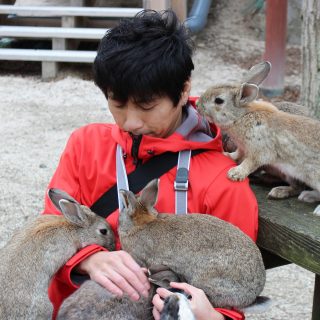Research
Our group is using theoretical methods such as numerical simulations and quasi-analytical models based on these simulations to elucidate the formation and evolution of the various structures of the universe. Our research topics range over various scales and epochs of the Universe from stars and black holes to galaxies and galaxy clusters and from just after the Big Bang to the present day, respectively.
First stars
The first generation stars in the universe (i.e., first stars) were the first objects born during the “Dark Age of the Universe” after the Big Bang, when no light-emitting objects existed at all. We are investigating the process of the gravitational gathering of matter to form the first stars, seeded by the initial density fluctuations generated at the Big Bang, mainly through numerical simulations. The nature of the initial density fluctuations is well constrained by observations of the cosmic microwave background radiation, and the understanding of the elementary physical processes involved in the formation of the first stars is well established, making first-principles studies possible.
First galaxies
The “Dark Ages of the Universe” came to an end with the formation of the first stars, and an era known as the “Cosmic Dawn” began, during which luminous stars were born one after another. The first generation galaxies (i.e., first galaxies), consisting of many stars, are thought to appear a little later than the first stars during the “Cosmic Dawn”. Therefore, we study the formation of the first galaxies by performing simulations beyond the period of first star formation. The formation of the first galaxies is a dynamic phenomenon that involves a complex interplay of various physical processes, such as the formation of stars from gas and their evolution to black holes, and the feedback process of powerful gas flows and light emitted from these objects (or their neighborhoods) to the surrounding environment. We are trying to understand these processes through simulations. With the recent launch of the James Webb Space Telescope in 2021, observations of the era of first galaxy formation have begun to progress rapidly, making it more important than ever to advance the theory of the first galaxies.
Galaxies/Galaxy clusters
Galaxies and galaxy clusters are the largest scale objects in our universe. To elucidate how they have formed and evolved from the Big Bang to the present day will directly lead to the elucidation of the evolution of the universe itself. Although it is difficult to completely describe the formation and evolution of galaxies and galaxy clusters with the current computational resources, it has recently become possible to reproduce the key observational features well by combining phenomenological models and numerical simulations. In collaboration with observational studies of galaxies, we are working to reveal the evolution of the universe from a theoretical point of view.
Supermassive black holes
Supermassive black holes, with a mass more than one million times that of the Sun, exist at the centers of most galaxies according to the observations and are thought to be important objects that have a significant impact on the evolution of galaxies. Such gigantic black holes probably do not form directly, but rather through a two-step process in which a seed black hole is created from a dying massive star and then grows by accreting surrounding matter. In order to reveal the origin of supermassive black holes, we are studying the formation and evolution of seed black holes. It is also known that the mass of a supermassive black hole is tightly correlated with the mass and velocity dispersion of the bulge (the ellipsoid at the center of the galaxy) of the galaxy hosting the black hole. This is believed to be the result of the growth of the black hole affecting the growth of the galaxy (or vice versa) and is called co-evolution. Therefore, we are also conducting galaxy formation simulations involving supermassive black holes in order to clarify the mechanism of coevolution.
Molecular clouds
Understanding molecular clouds, which bridge galaxies and stars that are far apart in scale, is key to elucidating the origin of the stars that make up our Galaxy. Molecular clouds are high-density gas clouds composed mainly of molecular hydrogen that form when the density of the low-density neutral hydrogen atomic gas that dominates the volume of the Galaxy increases, with overdense regions of molecular clouds experiencing the runaway gas accumulation due to their own gravity (self-gravity) that leads to the formation of individual stars. We use simulations to study how molecular clouds form on the galactic scale and how star formation proceeds on the molecular cloud scale.
Staff
-
 OKAMOTO TakashiProfessorEmailtakashi.okamoto(at)sci.hokudai.ac.jpOffice2-9-14
OKAMOTO TakashiProfessorEmailtakashi.okamoto(at)sci.hokudai.ac.jpOffice2-9-14 -
 SUGIMURA KazuyukiAssistant ProfessorEmailsugimura(at)sci.hokudai.ac.jpOffice2-9-11
SUGIMURA KazuyukiAssistant ProfessorEmailsugimura(at)sci.hokudai.ac.jpOffice2-9-11
Contact
ZIP Code 060-0810
Address Address : Kita 10, Nisi 8, Kita-ku, Sapporo 060-0810, JAPAN
TEL +81(JPN)-11-706-2693
FAX +81(JPN)-11-706-3498


